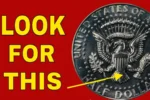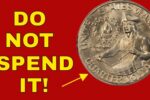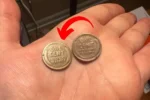How a War-Era Jefferson Nickel Became One of America’s Most Valuable Coins
Coin collecting is a hobby full of surprises. Some coins that look ordinary at first can be worth thousands of dollars. One such example is the war-era Jefferson nickel, a small five-cent coin that once filled pockets during World War II but is now considered one of America’s most valuable coins. What made this coin so special? How did a simple nickel become such a rare and prized collectible?
Let’s take a closer look at this fascinating story of history, metal changes, and a small coin with a big legacy.
Coin collecting is a hobby full of surprises. Some coins that look ordinary at first can be worth thousands of dollars. One such example is the war-era Jefferson nickel, a small five-cent coin that once filled pockets during World War II but is now considered one of America’s most valuable coins. What made this coin so special? How did a simple nickel become such a rare and prized collectible?
Let’s take a closer look at this fascinating story of history, metal changes, and a small coin with a big legacy.
Overview Table: War-Era Jefferson Nickel
| Feature | Details |
|---|---|
| Name | Jefferson Nickel (Wartime issue) |
| Years Minted | 1942 to 1945 |
| Composition | 35% Silver, 56% Copper, 9% Manganese |
| Mint Marks | P, D, S (above Monticello on reverse) |
| Notable Year | 1943-P, 1944-D |
| Face Value | 5 Cents |
| Current Value (Rare Condition) | $2,000 to over $10,000+ |
| Reason for Rarity | Silver content, errors, low mintage |
Design & Style
The Jefferson nickel was first introduced in 1938, replacing the Buffalo nickel. The design featured Thomas Jefferson on the front (obverse) and his home, Monticello, on the back (reverse). For the war-era nickels, the design remained the same, but there was one major change: the mint mark was moved above Monticello on the back side, making it easy to identify.
This small change in design was done on purpose to distinguish the silver-containing war nickels from the regular ones. It’s a simple, clean design, but for collectors, that mint mark placement is a key detail.
Engine & Performance
While coins don’t have engines or performance like cars, the “performance” of a coin can be understood in terms of how it was made and how well it stood the test of time. During the war years, nickel metal was needed for military production, especially in making tanks and aircraft. To save nickel, the U.S. Mint changed the metal mixture of the Jefferson nickel.
The wartime nickels were made using 35% silver, which gave them a different look and feel. They also aged differently than standard nickels. Many war nickels developed a darker tone or even rainbow-like colors due to the silver reacting over time, which actually adds to their appeal among collectors.
Ride & Handling
In coin terms, “handling” can refer to how the coin was used and survived through circulation. Many of these nickels were heavily used during the 1940s. Some were lost, damaged, or melted down over the years. A coin that has survived in excellent condition, especially uncirculated or with a rare error, becomes extremely valuable today.
For example, the 1943-P “Full Steps” Jefferson nickel is worth thousands because it shows every step of Monticello clearly—a sign of perfect striking and minimal wear.
Features & Tech
The most interesting “tech feature” of this coin is its metal composition. Unlike normal Jefferson nickels made of 75% copper and 25% nickel, the wartime versions had no nickel at all. Instead, they were a mix of copper, silver, and manganese.
Also, the mint mark being above Monticello was the first time the “P” mark (for Philadelphia) appeared on a U.S. coin. Before that, Philadelphia-minted coins had no mint mark at all. That small “P” has now become a symbol of the wartime nickel’s uniqueness.
Mileage & Fuel Efficiency
If we stretch this subheading to fit, we can say that these nickels went a long way. Produced during a time of global conflict, they were part of everyday transactions—used to buy groceries, stamps, even rationed goods. Now, decades later, they are worth far more than their original five-cent value.
Some rare types, like those with minting errors (such as double dies or wrong planchets), are now worth over $10,000 at auctions. That’s quite a journey for a simple coin that once bought a candy bar.
Price & Variants
Not all war-era Jefferson nickels are worth thousands, but certain years and mints are more valuable than others. Here’s a simple breakdown:
| Year-Mint | Type | Estimated Value (High Grade) |
|---|---|---|
| 1942-P (Silver) | Wartime Nickel | $50–$200 |
| 1943-P (Full Steps) | Rare High Quality | $1,000–$5,000+ |
| 1944-D (Error Coin) | Wrong Planchet | $10,000+ |
| 1945-S | Common Silver | $25–$100 |
The value depends on the condition, mint mark, and rarity. Many collectors search for the full set of war nickels as a way to honor the history behind them.
FAQs
Q. Why did they use silver in nickels during World War II?
A. Nickel was needed for the war, so the Mint replaced it with silver and other metals to save resources.
Q. How can I tell if I have a wartime Jefferson nickel?
A. Look at the back of the coin—if the mint mark is above Monticello, it’s likely a war-era coin.
Q. Are all war nickels valuable?
A. Most are worth more than face value, but only rare types in excellent condition or with errors are highly valuable.
Q. Can I still find them in circulation?
A. It’s very rare, but possible. Most are found in old coin collections or inherited stashes.
Final Verdict
The story of the war-era Jefferson nickel is one of simple beginnings and historic value. Born out of necessity during World War II, this small coin helped the war effort and left behind a legacy of unique design, unusual materials, and collector value. Whether you’re a beginner in coin collecting or someone who inherited a few old coins, it’s worth checking your nickels—you never know when you might be holding a small piece of valuable history.
Overview Table: War-Era Jefferson Nickel
| Feature | Details |
|---|---|
| Name | Jefferson Nickel (Wartime issue) |
| Years Minted | 1942 to 1945 |
| Composition | 35% Silver, 56% Copper, 9% Manganese |
| Mint Marks | P, D, S (above Monticello on reverse) |
| Notable Year | 1943-P, 1944-D |
| Face Value | 5 Cents |
| Current Value (Rare Condition) | $2,000 to over $10,000+ |
| Reason for Rarity | Silver content, errors, low mintage |
Design & Style
The Jefferson nickel was first introduced in 1938, replacing the Buffalo nickel. The design featured Thomas Jefferson on the front (obverse) and his home, Monticello, on the back (reverse). For the war-era nickels, the design remained the same, but there was one major change: the mint mark was moved above Monticello on the back side, making it easy to identify.
This small change in design was done on purpose to distinguish the silver-containing war nickels from the regular ones. It’s a simple, clean design, but for collectors, that mint mark placement is a key detail.
Engine & Performance
While coins don’t have engines or performance like cars, the “performance” of a coin can be understood in terms of how it was made and how well it stood the test of time. During the war years, nickel metal was needed for military production, especially in making tanks and aircraft. To save nickel, the U.S. Mint changed the metal mixture of the Jefferson nickel.
The wartime nickels were made using 35% silver, which gave them a different look and feel. They also aged differently than standard nickels. Many war nickels developed a darker tone or even rainbow-like colors due to the silver reacting over time, which actually adds to their appeal among collectors.
Ride & Handling
In coin terms, “handling” can refer to how the coin was used and survived through circulation. Many of these nickels were heavily used during the 1940s. Some were lost, damaged, or melted down over the years. A coin that has survived in excellent condition, especially uncirculated or with a rare error, becomes extremely valuable today.
For example, the 1943-P “Full Steps” Jefferson nickel is worth thousands because it shows every step of Monticello clearly—a sign of perfect striking and minimal wear.
Features & Tech
The most interesting “tech feature” of this coin is its metal composition. Unlike normal Jefferson nickels made of 75% copper and 25% nickel, the wartime versions had no nickel at all. Instead, they were a mix of copper, silver, and manganese.
Also, the mint mark being above Monticello was the first time the “P” mark (for Philadelphia) appeared on a U.S. coin. Before that, Philadelphia-minted coins had no mint mark at all. That small “P” has now become a symbol of the wartime nickel’s uniqueness.
Mileage & Fuel Efficiency
If we stretch this subheading to fit, we can say that these nickels went a long way. Produced during a time of global conflict, they were part of everyday transactions—used to buy groceries, stamps, even rationed goods. Now, decades later, they are worth far more than their original five-cent value.
Some rare types, like those with minting errors (such as double dies or wrong planchets), are now worth over $10,000 at auctions. That’s quite a journey for a simple coin that once bought a candy bar.
Price & Variants
Not all war-era Jefferson nickels are worth thousands, but certain years and mints are more valuable than others. Here’s a simple breakdown:
| Year-Mint | Type | Estimated Value (High Grade) |
|---|---|---|
| 1942-P (Silver) | Wartime Nickel | $50–$200 |
| 1943-P (Full Steps) | Rare High Quality | $1,000–$5,000+ |
| 1944-D (Error Coin) | Wrong Planchet | $10,000+ |
| 1945-S | Common Silver | $25–$100 |
The value depends on the condition, mint mark, and rarity. Many collectors search for the full set of war nickels as a way to honor the history behind them.
FAQs
Q. Why did they use silver in nickels during World War II?
A. Nickel was needed for the war, so the Mint replaced it with silver and other metals to save resources.
Q. How can I tell if I have a wartime Jefferson nickel?
A. Look at the back of the coin—if the mint mark is above Monticello, it’s likely a war-era coin.
Q. Are all war nickels valuable?
A. Most are worth more than face value, but only rare types in excellent condition or with errors are highly valuable.
Q. Can I still find them in circulation?
A. It’s very rare, but possible. Most are found in old coin collections or inherited stashes.
Final Verdict
The story of the war-era Jefferson nickel is one of simple beginnings and historic value. Born out of necessity during World War II, this small coin helped the war effort and left behind a legacy of unique design, unusual materials, and collector value. Whether you’re a beginner in coin collecting or someone who inherited a few old coins, it’s worth checking your nickels—you never know when you might be holding a small piece of valuable history.




